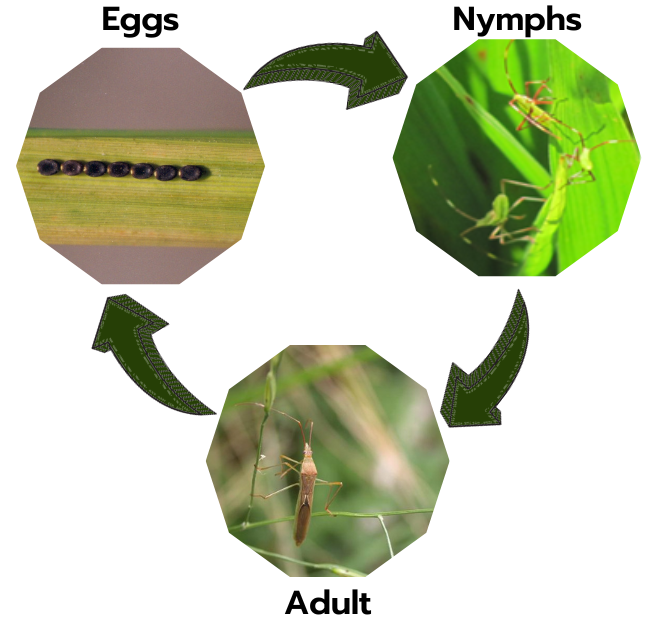
A single female lays an average of 200-300 eggs in batches of 10-20, usually arranged in two or three straight rows along the midrib on the upper surface of the leaf blade. The eggs are oval, slightly flattened on the top. They are creamy white when freshly laid, but become darker as they approach hatching in 5-8 days.
The freshly emerged nymphs are tiny and green, but become brownish as they grow. They start feeding 3-4 h after hatching, and undergo five nymphal instars in a total period of 25-30 days to become adults.
The adult insect is long and slender, about 14-17 mm long and 3-4 mm wide. It is phototropic and diurnal, but is most active during cooler periods of early mornings and evenings.

Both nymphs and adults feed on developing grains by inserting their proboscises at points where palea and lemma meet. Diffused brown spots caused by the exudation of the sap mark the points of insertion (Fig.D). Grains damaged during milk stage remain empty. The panicles in heavily infested fields contain many shriveled and unfilled grains and usually remain erect. In severe cases of infestation, most grains in a field are sucked empty and the straw has an off-flavor, which is unattractive to cattle. When rice bugs feed in soft or hard dough endosperm in a solid state, they inject enzymes to predigest it. Damage during the dough stage causes discoloration of mature grain and causes weakness in the kernel. Such rice has lower milling quality or is pecky rice of inferior grade. Partially damaged grains also have an off-flavor even after cooking. Injury during the milk stage causes yield loss, while damage during the dough stage impairs grain quality.
Remove weeds from bunds and in the rice field as they act as alternate hosts.
Use of decomposing crabs/frogs as bait - As the filling of paddy grain starts, locally available crabs/frogs can be smashed and put on pointed bamboo sticks in paddy fields as bait to attract gundhi bugs.
Under severe infestations, spray the following insecticides during evening hours only.
Chlorpyriphos 20 EC @ 500 ml per acre. If needed spray again after 10 days.